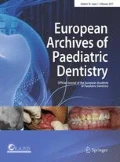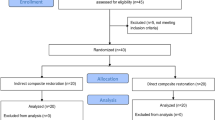Abstract
Background
Severely hypomineralised first permanent molars (FPMs) in children with molar incisor hypomineralisation (MIH) often require comprehensive restorative treatment. Different types of treatment have been described in the literature, including conservative treatment and use of various types of crowns.
Aim
To describe a gentle and minimally invasive method for restoration of severely hypomineralised FPMs and to perform an initial, practice-based evaluation of the outcome for up to a 10-year follow-up period.
Methods
Thirty-three children (mean age 12.1 years, SD 2.6) were treated with 57 minimally invasive cast adhesive gold copings (CAC). Sedation, local analgesia using a computer-controlled injection device, and behaviour management techniques were used to secure gentle care of the child. In cases with need for treatment of several teeth, the teeth not under treatment were covered by splints. The preparation border was placed in sound enamel, allowing 1/2–2 mm space to secure sufficient strength of the final restoration, which was cemented with dual composite cement. Follow-up examinations were performed by the dentists referring the children.
Results
All the children referred for treatment could be treated using this procedure, and of the 57 CAC, 56 (98.2 %) were still functioning after a mean observation period of 38.6 months (SD 28.9).
Conclusion
In addition to existing types of treatment, minimally invasive CAC seems to be a feasible and useful method for restoration of FPMs with demarcated opacities and post-eruptive surface loss in children with MIH.


Similar content being viewed by others
References
Cvar JF, Ryge G. Reprint of criteria for the clinical evaluation of dental materials. Clin Oral Invest. 2005;9:215–32.
Hickel R, Roulet J-F, Bayne S, et al. Recommendations for conducting controlled clinical studies of dental restorative materials. Clin Oral Invest. 2007;11:5–33.
Jälevik B, Klingberg G, Barregård L, Norén JG. The prevalence of demarcated opacities in first permanent molars in a group of Swedish children. Acta Odontol Scand. 2001;59:255–60.
Jälevik B, Klingberg G. Dental treatment, dental fear and behaviour management problems in children with severe enamel hypomineralisation of their first permanent molars. Int J Paediatr Dent. 2002;12:24–32.
Koch MJ, Garcia-Godoy F. The clinical performance of laboratory-fabricated crowns placed on first permanent molars with developmental defects. JADA. 2000;131:1285–90.
Kotsanos N, Kaklamanos EG, Arapostathis K. Treatment management of first permanent molars in children with molar incisor hypomineralisation. Eur J Paediatr Dent. 2005;6:179–84.
Lygidakis N. Treatment modalities in children with teeth affected by molar–incisor enamel hypomineralisation (MIH): a systematic review. Eur Arch Paediatr Dent. 2010;1:65–74.
Mejàre I, Bergman E, Grindefjord M. Hypomineralised molars and incisors of unknown origin: treatment outcome at age 18 years. Int J Paediatr Dent. 2005;15:20–8.
Ryge G. Clinical criteria. Int Dent J. 1980;30:347–58.
Stokholm R, Isidor F, Ravnholt G. Tensile bond strength of resin luting cement to a porcelain fusing noble alloy. Int J Prosthodont Dent. 1996;9:323–30.
Weerheijm KL. Molar incisor hypomineralisation (MIH). Eur J Paediatr Dent. 2003;4:114–20.
Weerheijm KL, Jälevik B, Alaluusua S. Molar incisor hypomineralisation. Caries Res. 2001;35:390–1.
William V, Messer LB, Burrow MF. Molar incisor hypomineralisation: review and recommendations for clinical management. Pediatr Dent. 2006;28:224–32.
Wogelius P, Haubek D, Poulsen S. Prevalence and distribution of demarcated opacities in permanent 1st molars and incisors in 6 to 8-year-old Danish children. Acta Odontol Scand. 2008;66:58–64.
Zagdwon AM, Fayle SA, Pollard MA. A prospective clinical trial comparing preformed metal crowns and cast restorations for defective first permanent molars. Eur J Paediatr Dent. 2003;4:138–42.
Acknowledgments
This study was financed by a grant from The Public Health Dentists Association, Denmark.
Author information
Authors and Affiliations
Corresponding author
Rights and permissions
About this article
Cite this article
Gaardmand, E., Poulsen, S. & Haubek, D. Pilot study of minimally invasive cast adhesive copings for early restoration of hypomineralised first permanent molars with post-eruptive breakdown. Eur Arch Paediatr Dent 14, 35–39 (2013). https://doi.org/10.1007/s40368-012-0002-7
Received:
Accepted:
Published:
Issue Date:
DOI: https://doi.org/10.1007/s40368-012-0002-7




